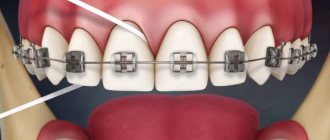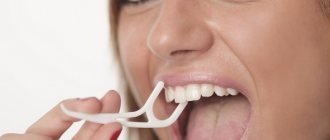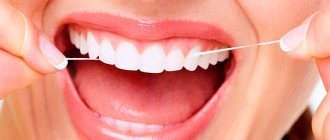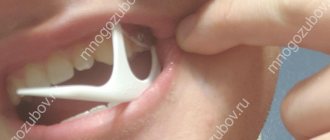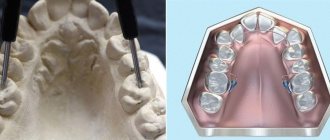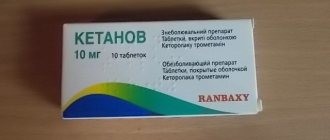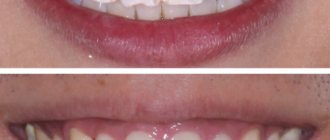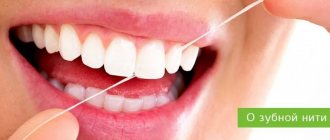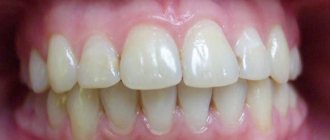4415
In the process of providing therapeutic assistance during dental treatment, the doctor often causes mechanical trauma to the surrounding tissues of the gums and organ enamel.
At the same time, the damage is not accidental; it is necessary for the highest quality of medical procedures.
One of these actions is retraction of the gum area.
Purpose of gum retraction procedure
In medical terminology, retraction is interpreted as the deliberate pulling back of the soft tissue of the gum, as a result of which its groove is subject to artificial expansion.
This, in turn, opens the root part to the required size, and the threshold of the external and internal boundaries of the tooth is significantly lowered.
This method is carried out using special threads made from twisted dense fiber of various thicknesses and sizes.
Devices are produced individually and subjected to high-tech processing.
Types and choice of material
Mechanical retraction is carried out using rings, silicone caps, twisted, braided threads. Three types of threads are used:
- not impregnated with a special composition, for persons with allergies to chemical components, who have pathologies in the cardiovascular system (adrenaline is used in the impregnation),
- cotton – elastic and soft, have a hemostatic effect,
- fabric tubes - produce an effect similar to cotton tubes, but are better retained on the edge of the gums due to their inherent structure.
To read: Mini dental implants for the upper jaw
Copper rings are rarely used, due to the difficulty of selecting them in exact accordance with the size of the patient’s dental neck.
The modern method of retraction is laser, which has not yet been fully studied in terms of contraindications and is very expensive. In orthopedics, the method of retraction with a special paste has proven itself to be useful for obtaining impressions for prosthetics.
Its protective effect lasts no more than 5 minutes, which does not allow using this method when working with caries.
Indications and contraindications
The root exposure procedure using pulling threads is indicated in the following clinical cases:
- bite defects of any severity;
- removal of destroyed fragments of the jaw row;
- gum therapy;
- during anesthesia to enhance the targeted effect of the drug;
- with professional whitening in a clinic;
- in the production of veneers and crowns;
- when removing rocky deposits using ultrasonic influence;
- as a manipulation that stops bleeding that occurs during the treatment of surgical actions of a doctor.
Contraindications to the procedure have not yet been thoroughly identified. The main thing that should be adhered to is the absence of inflammatory, purulent and infectious lesions of the soft tissues of the oral cavity.
Retraction thread in dentistry
During dental treatment, dentists are often forced, for one reason or another, to injure the gums and teeth surrounding them in order to perform their manipulations efficiently. Such injuries include gum retraction.
What is retraction?
Retraction is literally translated as “pulling back,” and this word reflects the essence of the procedure. Gum retraction is the widening of the gum sulcus, which exposes the tooth root and lowers the level of the gum.
This technique is carried out through the use of special retraction threads, which are a finished product in the form of twisted fibers of various sizes and lengths, subjected to special processing. The selection of thread is done individually, which depends on the size of the gum groove, that is, its depth and width.
Only an experienced specialist can select a thread, since its size must exactly correspond to the specific properties of a particular area of the patient’s oral cavity. Only if these conditions are met will the correct movement of tissues be guaranteed.
In dentistry, retraction thread is used to carry out a procedure that precedes dental restoration - before taking an impression.
In what cases is this necessary?
Gum retraction is necessary:
– if it is necessary to protect the gums from injury and gingival fluid during treatment;
– in case of bleeding during other dental procedures;
– if it is necessary to carry out manipulations on the area of the tooth that is located under the gum;
– tooth whitening;
– production of crowns, dentures or veneers and their installation.
Characteristics and composition
Twisted retraction cords are made from 100% cotton. This material has an absorbent effect. For gum retraction, it is possible to use unimpregnated threads, but the most common in practical use are fibers with factory impregnation, because they do not require time and are more economical.
The liquid has a universal composition that allows the specialist to perform optimal contraction of muscle tissue and narrowing of blood vessels during bleeding. Thanks to the retraction thread, Gingi Pak, for example, it is possible to install the necessary device between the teeth without bleeding or other unpleasant phenomena.
Kinds
There are three types of threads:
– Cotton, made from fibers. They are very soft and have excellent absorbent properties.
– Tubes made of fabric. In terms of their absorbent qualities, they are similar to cotton, however, due to the peculiarities of weaving, these threads are better located in the gingival groove. They are most suitable for retraction.
– Threads that are not impregnated with a chemical composition. They are used for mechanical retraction if the patient cannot undergo combined retraction for one reason or another.
Currently, new retraction techniques are emerging, which are based on the use of diode lasers, which are completely painless and safe. The difficulty is that the equipment needed for such retraction is very expensive.
Basic techniques of gum retraction
There are three main methods of gum retraction.
1) Mechanical method.
Gingival mechanical retraction involves the use of caps, rings and sutures. These items are inserted by the doctor under the gum, due to which it actually moves back. The main property of the mechanical method is painlessness, due to which it is mainly carried out under local anesthesia.
In addition, mechanical retraction requires quite a lot of time, since the specialist must constantly monitor the depth of retraction; all manipulations must be carried out carefully and slowly, measuring the level of the periodontal sulcus.
The presence of such difficulties has become the reason that now mechanical retraction is almost never carried out, especially in cases where the gum needs to be moved back on several teeth at once. In addition to its complexity, mechanical retraction has another disadvantage.
Since gum tissue is highly sensitive, even the slightest mechanical impact can cause serious bleeding or damage the attachment of the tooth in the jawbone.
2) Surgical method. This method involves the complete elimination of part of the gum tissue using surgical electrical devices or an ordinary scalpel. This method is very radical, so it is used only in the following cases:
– if gum correction is necessary;
– if it is impossible to use other methods due to various reasons.
3) Chemical method. Its essence lies in the use of special pastes, solutions or gels that help contract gum tissue, due to which the gum edge is pulled back for some time.
It should be immediately noted that the chemical method is not suitable for all patients, since most drugs contain adrenaline. This substance, even in small quantities, increases blood pressure and increases heart rate, and this is contraindicated for people with cardiac arrhythmias, ischemia and hypertension.
In addition, gum tissue can simply reject chemicals, and in this case, chemical retraction is impossible.
Products containing aluminum oxide and kaolin are considered to be the most gentle for gum retraction. They are produced in the form of a gel or paste and placed in special cartridges that allow precise control of their application to the gums. With the chemical method, it is especially important to observe the duration of exposure to avoid chemical burns.
Combined technique of gum retraction
In modern dentistry, the three main techniques are very rarely used separately. Experts prefer to combine these methods. The mechanical-chemical method has gained the greatest popularity. For this type of retraction, retraction threads are most often used in dentistry.
To successfully carry out the procedure, the specialist must accurately determine the depth and width of the gum groove, and then select threads of a certain thickness and size. As in the chemical method, the dentist must ask the patient whether he suffers from heart disease, whether he has intolerance or allergies to certain chemicals.
It is allowed to use no more than four threads at a time to avoid chemical burns.
To install the retraction thread, a special instrument of a certain size is used (most often the device has rounded edges and a thin blade).
When performing the procedure, the dentist must show maximum attention and skill to avoid injury when positioning the thread. Before inserting the impression material, it is necessary to remove the thread from the groove.
In some cases, after removing the thread, the specialist prefers to rinse the surface, since it is recommended that it be as dry as possible.
Retraction thread Gingi Pack
Consists of 100% cotton, impregnated with aluminum sulfate.
Properties and advantages of retraction thread with epinephrine:
- It has a unique texture that makes it easy to hold in your hands.
- Thanks to the impregnation method, uniform distribution of the solution along the entire length is guaranteed.
- It features unique packaging and is cut with a sharpened cap without scissors.
- The thread is sterile.
- Fibers do not fall off.
- Possibility of additional impregnation.
Retraction thread Sure Cord
Also made from 100% cotton, it consists of many small, interconnected loops. This allows it to be firmly fixed in the intergingival groove. There are several sizes available, the thickness of the threads will be different. Dentists use such threads when working with veneers.
Source: https://fb.ru/article/368084/retraktsionnaya-nit-v-stomatologii
Selection and types of material
The threads can be either completely dry or treated with agents with a therapeutic effect. The last option is used most often.
The choice of product always remains with the specialist - it is he who, based on the clinical situation, will choose the best option.
There are often cases when a patient suffers from individual intolerance to the components of medications, so it is necessary to use dry material.
The qualitative composition of the retraction thread differs by type:
- 100% cotton – treated with compounds that stop bleeding and have a disinfecting effect;
- cotton without impregnation - indicated when other options are unacceptable for clinical reasons;
- Tubular fabric – characterized by increased moisture absorption.
By appearance:
- twisted - not very strong and durable. They often tear, breaking up into individual fibers;
- knitted - indicated for use only to ensure the integrity of soft tissue fragments during dental preparation;
- wicker ones are the most durable and multifunctional products.
Features of dental treatment under a microscope, pros and cons of the method.
Come here if you are interested in the intricacies of using rubber dams in dentistry.
At this address https://www.vash-dentist.ru/lechenie/zubyi/karies/innovatsionnoe-ustraneniei-icon.html we’ll talk about Icon treatment of caries.
Selection of material
Retraction threads in dentistry are selected individually, it depends on the depth and width of the gingival groove. Only a specialist (dentist) can select the thread. Dental sutures for retraction are divided into several types according to the method of twisting:
- knitted;
- wicker;
- twisted.
Knitted threads are fabric tubes. They have high absorption (the property of absorbing liquids). The special weave structure allows for a tight and comfortable fit to the gum groove. When the devices are pre-impregnated with a hemostatic solution, it is released during installation due to the compression of the loops. Some manufacturers produce reinforced products (reinforcement material is copper wire), they fit better on the furrows. Knitted ones are considered the best option for the retraction procedure. Braided ones are durable, and fiber stripping of loops is practically eliminated. Twisted (twisted) cotton consists of grouped or single bundles of fibers. They are distinguished by their softness and the highest absorption, but when used, there is a high probability of fiber disintegration and inclusion of fibers in casts.
Based on the type of material, threads are divided into linen and cotton.
There are many labels for dental floss. Each manufacturer labels them according to their own classification, since there is no single system. Packing – placing a retraction thread in the gingival pocket. There is a double wrap, which involves laying two threads; this method is used for inflamed gums that are prone to bleeding. Let's consider the marking method using the example of Ultrapack knitted thread:
- Ultrapack 000 – ultra-thin, used for double packing, intended for front teeth. Doctors use it to fix veneers. It is suitable for delicate and dense fabrics.
- Ultrapack 00 – thin nodular, used for double packing and restorative operations, such as cementation or veneer preparation. Suitable for thin fabrics prone to tearing.
- Ultrapack 0 – slightly thicker than the previous ones, used for double packing and restoration operations. Often used for lower front teeth. It is recommended in cases of bleeding.
- Ultrapak 1 - the scope of application of this thread is similar to Ultrapak 0, but can be used on premolars with moderate tenderness of the gum tissue. Recommended for crown preparations and as protection before procedures on front teeth.
- Ultrapack 2 is the most used in dentistry. Designed for durable fabrics, used for double packing as a top thread.
- Ultrapack 3 – used in case of thick gum tissues, their installation requires more effort, as well as for double packing.
For the desired effect for one or another type of retraction, dental products are impregnated with a special solution:
- adrenaline (or epinephrine) hydrochloride - has a vasoconstrictor effect, which reduces the volume of soft tissues; people suffering from arterial hypertension should avoid using threads soaked in this solution;
- zinc chloride – has a strong astringent effect;
- aluminum chloride – a water-repellent, astringent substance, intended for working with damaged gums;
- aluminum sulfate - has the same effect as aluminum chloride, but is undesirable for damaged tissues;
- alum double aluminum sulfate - has an astringent, vasoconstrictor, hemostatic effect;
- ferrous sulfate - constricts blood vessels, stops bleeding; use on the front teeth is undesirable, because the solution stains soft tissues.
Products with impregnation are used in cases of long operations; short-term manipulations are performed using unimpregnated threads, but with the preliminary placement of special pastes or gels into the gum pocket using a syringe. Examples of pastes: Retragel, Expasyl, Retrac, MagicFoam Cord and many others.
Stages of staging
The technique of performing tissue retraction is carried out in several successive stages:
- instrumental study of the furrow , replacement of its parameters and required depth;
- administration of an anesthetic drug;
- preparation of the thread - impregnation with a hemostatic agent, determination of dimensions. Everything is done in strict sterility to prevent infection of the internal layers;
- the product is inserted to a shallow depth , after which the tooth is treated;
Upon completion of all therapeutic measures, the doctor uses a sharp device to pull the end and pull the thread out of the cavity.
Methods used
In medical practice, several methods are available to retract the soft tissue of the gums. Which one to prefer is the prerogative of the doctor. The decision is made based on the complexity of the diagnosis and the specifics of its treatment.
Mechanical method
The thread is packaged in a special tube and comes with a blade. They are dry and medicated.
Step-by-step algorithm for the doctor’s actions:
- anesthesia of the working surface;
- preparation - determining the length of the bundle, impregnating it with the composition (if necessary);
- packing - to the required depth using a special packer device, the product is delivered to the required place. The manipulation is carried out slowly and carefully. Normally, the patient should not experience discomfort;
- cutting off excess ends with scissors.
The procedure is simple, this is its advantage. Belongs to the category of gentle measures.
Has disadvantages:
- risk of accidental injury to soft tissue mucosa;
- duration in time;
- small fragments of fibers can impair the aesthetic content during subsequent restoration.
Causes of yellow plaque on teeth and how to get rid of the problem.
This publication contains all the most important things about root canal cleaning.
Read here about the symptoms of a tooth abscess and its treatment methods.
Surgical
The method is indicated for pathological growth of soft tissues in the border zone of the gums. This clinical picture makes it impossible to use other techniques.
The manipulation is performed under local anesthesia in a standard manner. The main tool is the surgeon's scalpel.
Modern dental clinics use bloodless laser technology for this purpose, but this service is available only to prestigious medical institutions.
The surgical method is fraught with complications of varying degrees of intensity, the main of which are:
- formation of a purulent pocket;
- development of internal inflammation;
- excessive root exposure;
It has a serious contraindication to the procedure – periodontitis. Retraction is often accompanied by pain.
Chemical
The main purpose of the method is to provide impressions. Additional accessories - a syringe and a gel-based product. Step-by-step introduction technology:
- The paste is drawn into a syringe and distributed into the gum cavity. Then it is lightly pressed down by the coronal part of the organ;
- after a few minutes the mixture is removed, not leaving even small fragments. The working surface is washed with running water;
- the crown dries naturally.
Flaws:
- the risk of chemical burns if the exposure time of the paste is incorrectly calculated;
- the possibility of manifestations of individual intolerance to the components of the product.
The advantage is the speed of manipulation and high results.
Combined
A combination of two options is possible:
- the use of products impregnated with a therapeutic composition immediately before administration;
- threads and pastes are used in a certain order, alternately. This way you can expand the groove more efficiently. The thread for this purpose is taken with the smallest diameter. A few minutes after implantation, it is removed, and a gel drawn into a syringe is applied to this area.
Methods used
In dentistry, the following methods are used for retraction:
- Mechanical. The dentist installs the selected type of ring or thread under the gum manually.
- Chemical method. Gels, special solutions and pastes that reduce gum tissue are used less frequently and only for patients who are not prone to allergies, since they contain kaolin and aluminum oxide. The solution or paste is injected with a syringe or medical pistol. Their duration of action is limited by the risk of chemical burns to the gums. In addition, this method is contraindicated for people with hypertension, ischemia, or cardiac pathologies, since the adrenaline in the product can cause a rapid heartbeat and increased blood pressure in the patient. Ferrous sulfate provides a hemostatic effect, but gives the enamel a dark color and is not suitable for the front incisors. Epinephrine, aluminum sulfate and chloride (if tissues are damaged), and zinc chloride with an astringent effect are used to constrict blood vessels.
To read: Proper oral hygiene
- Surgical. Overgrown gum tissue is removed with a scalpel, a special electrical device, or a laser. Used only when absolutely necessary.
- Combined method. Doctors often prefer to combine the above methods. The mechanical-chemical method is most often used. Having checked whether the patient has any contraindications (allergies or intolerance to the chemical components of the impregnation, cardiac pathologies), and determined the width and depth of the gingival groove, the doctor inserts a thread under the gum (under local anesthesia). Up to 4 threads can be used at a time.
Depending on the characteristics of the patient, the doctor selects an acceptable method of retraction or refuses manipulation.
Recommendations for the rehabilitation period
The recovery period after using this technique and targeted treatment may include physical discomfort, pain, bleeding, and swelling of the mucosal tissue.
To minimize these sensations, you should use products that strengthen the gums and relieve inflammation:
- medicinal ointments and gels;
- rinsing with decoctions of medicinal plants;
- in difficult cases - a course of antibiotics.
Teeth should be brushed only with a soft brush, with pastes that do not contain abrasive and whitening components, preferably on a professional basis.
Carefully remove food residues by rinsing and using an irrigator in a gentle mode.
You should avoid eating too cold, hot foods and drinks, hard, sticky and viscous foods that can injure the affected areas.
Possible complications
The quality of the actions performed depends on the doctor’s qualifications and practice. Medical unprofessionalism is the most common cause of complications.
Less often, they occur against the background of non-compliance with hygiene measures and the patient’s weak immune system.
Possible complications:
- aggravation of periodontitis by the formation of pockets;
- too much exposure of the root zone, caused by very deep immersion of the thread.
A careful study of the clinical picture and the experience of a specialist will help to avoid these problems. To eliminate it, more radical methods are used, including surgical intervention.
Popular manufacturers
The following materials from well-known brands engaged in the production of dental instruments, devices and dental care products have proven themselves better than others:
- Gingi Pack – composition – cotton, impregnation – aluminum sulfate. It has a unique texture, holds firmly in your hands, and does not slip.
The applied composition is distributed along its entire length as evenly as possible, and comes with convenient packaging and a cap that eliminates the need to use scissors.The fibers do not crumble, the fabric is sterile - 100%. If necessary, it can be impregnated with additional composition;
- Sure Cord - its structure is a set of microscopic twisted fibers interconnected into a durable fabric. Fits securely into the groove. Extensive range of sizes, thickness varies in the required range. An ideal solution for installing veneers.
Retraction thread in dentistry - a small helper in solving big problems
585
In the process of providing therapeutic assistance during dental treatment, the doctor often causes mechanical trauma to the surrounding tissues of the gums and organ enamel.
At the same time, the damage is not accidental; it is necessary for the highest quality of medical procedures.
One of these actions is retraction of the gum area.
Purpose of gum retraction procedure
In medical terminology, retraction is interpreted as the deliberate pulling back of the soft tissue of the gum, as a result of which its groove is subject to artificial expansion.
This, in turn, opens the root part to the required size, and the threshold of the external and internal boundaries of the tooth is significantly lowered.
This method is carried out using special threads made from twisted dense fiber of various thicknesses and sizes.
Devices are produced individually and subjected to high-tech processing.
Indications and contraindications
The root exposure procedure using pulling threads is indicated in the following clinical cases:
- bite defects of any severity;
- removal of destroyed fragments of the jaw row;
- gum therapy;
- during anesthesia to enhance the targeted effect of the drug;
- with professional whitening in a clinic;
- in the production of veneers and crowns;
- when removing rocky deposits using ultrasonic influence;
- as a manipulation that stops bleeding that occurs during the treatment of surgical actions of a doctor.
Contraindications to the procedure have not yet been thoroughly identified. The main thing that should be adhered to is the absence of inflammatory, purulent and infectious lesions of the soft tissues of the oral cavity.
Selection and types of material
The threads can be either completely dry or treated with agents with a therapeutic effect. The last option is used most often.
The choice of product always remains with the specialist - it is he who, based on the clinical situation, will choose the best option.
There are often cases when a patient suffers from individual intolerance to the components of medications, so it is necessary to use dry material.
The qualitative composition of the retraction thread differs by type:
- 100% cotton – treated with compounds that stop bleeding and have a disinfecting effect;
- cotton without impregnation - indicated when other options are unacceptable for clinical reasons;
- Tubular fabric – characterized by increased moisture absorption.
By appearance:
- twisted - not very strong and durable. They often tear, breaking up into individual fibers;
- knitted - indicated for use only to ensure the integrity of soft tissue fragments during dental preparation;
- wicker ones are the most durable and multifunctional products.
Stages of staging
The technique of performing tissue retraction is carried out in several successive stages:
- instrumental study of the furrow , replacement of its parameters and required depth;
- administration of an anesthetic drug;
- preparation of the thread - impregnation with a hemostatic agent, determination of dimensions. Everything is done in strict sterility to prevent infection of the internal layers;
- the product is inserted to a shallow depth , after which the tooth is treated;
Upon completion of all therapeutic measures, the doctor uses a sharp device to pull the end and pull the thread out of the cavity.
Methods used
In medical practice, several methods are available to retract the soft tissue of the gums. Which one to prefer is the prerogative of the doctor. The decision is made based on the complexity of the diagnosis and the specifics of its treatment.
Mechanical method
The thread is packaged in a special tube and comes with a blade. They are dry and medicated.
Step-by-step algorithm for the doctor’s actions:
- anesthesia of the working surface;
- preparation - determining the length of the bundle, impregnating it with the composition (if necessary);
- packing - to the required depth using a special packer device, the product is delivered to the required place. The manipulation is carried out slowly and carefully. Normally, the patient should not experience discomfort;
- cutting off excess ends with scissors.
The procedure is simple, this is its advantage. Belongs to the category of gentle measures.
Has disadvantages:
- risk of accidental injury to soft tissue mucosa;
- duration in time;
- small fragments of fibers can impair the aesthetic content during subsequent restoration.
Surgical
The method is indicated for pathological growth of soft tissues in the border zone of the gums. This clinical picture makes it impossible to use other techniques.
The manipulation is performed under local anesthesia in a standard manner. The main tool is the surgeon's scalpel.
Modern dental clinics use bloodless laser technology for this purpose, but this service is available only to prestigious medical institutions.
The surgical method is fraught with complications of varying degrees of intensity, the main of which are:
- formation of a purulent pocket;
- development of internal inflammation;
- excessive root exposure;
It has a serious contraindication to the procedure – periodontitis. Retraction is often accompanied by pain.
Chemical
the purpose of the method is to provide impressions. Additional accessories - a syringe and a gel-based product. Step-by-step introduction technology:
- The paste is drawn into a syringe and distributed into the gum cavity. Then it is lightly pressed down by the coronal part of the organ;
- after a few minutes the mixture is removed, not leaving even small fragments. The working surface is washed with running water;
- the crown dries naturally.
Flaws:
- the risk of chemical burns if the exposure time of the paste is incorrectly calculated;
- the possibility of manifestations of individual intolerance to the components of the product.
The advantage is the speed of manipulation and high results.
Combined
A combination of two options is possible:
- the use of products impregnated with a therapeutic composition immediately before administration;
- threads and pastes are used in a certain order, alternately. This way you can expand the groove more efficiently. The thread for this purpose is taken with the smallest diameter. A few minutes after implantation, it is removed, and a gel drawn into a syringe is applied to this area.
Recommendations for the rehabilitation period
The recovery period after using this technique and targeted treatment may include physical discomfort, pain, bleeding, and swelling of the mucosal tissue.
To minimize these sensations, you should use products that strengthen the gums and relieve inflammation:
- medicinal ointments and gels;
- rinsing with decoctions of medicinal plants;
- in difficult cases - a course of antibiotics.
Teeth should be brushed only with a soft brush, with pastes that do not contain abrasive and whitening components, preferably on a professional basis.
Carefully remove food residues by rinsing and using an irrigator in a gentle mode.
You should avoid eating too cold, hot foods and drinks, hard, sticky and viscous foods that can injure the affected areas.
Possible complications
The quality of the actions performed depends on the doctor’s qualifications and practice. Medical unprofessionalism is the most common cause of complications.
Less often, they occur against the background of non-compliance with hygiene measures and the patient’s weak immune system.
Possible complications:
- aggravation of periodontitis by the formation of pockets;
- too much exposure of the root zone, caused by very deep immersion of the thread.
A careful study of the clinical picture and the experience of a specialist will help to avoid these problems. To eliminate it, more radical methods are used, including surgical intervention.
Popular manufacturers
The following materials from well-known brands engaged in the production of dental instruments, devices and dental care products have proven themselves better than others:
- Gingi Pack – composition – cotton, impregnation – aluminum sulfate. It has a unique texture, holds firmly in your hands, and does not slip. The applied composition is distributed along its entire length as evenly as possible, and comes with convenient packaging and a cap that eliminates the need to use scissors. The fibers do not crumble, the fabric is sterile - 100%. If necessary, it can be impregnated with additional composition;
- Sure Cord - its structure is a set of microscopic twisted fibers interconnected into a durable fabric. Fits securely into the groove. Extensive range of sizes, thickness varies in the required range. An ideal solution for installing veneers.
Price
The cost of the procedure is determined by two components - the price of the material and payment for the services of a specialist. How much the manipulation will cost depends on the region of residence of the patient, the clinic, and the qualifications of the doctor. On average, it costs about 550 rubles, excluding painkillers.
Thread price:
- Gingi Pack – from 380 rubles;
- Sure Cord – from 740 rubles.
The video provides additional information on the topic of the article.
Reviews
Without gum retraction, it is impossible to treat a large number of dental diagnoses; it is difficult to carry out prosthetics and professional hygiene measures.
If you have already experienced the therapeutic benefits of this technique, or you did not like something in the process of its implementation, you can share your own opinion in the “comments” section.
, please select a piece of text and press Ctrl+Enter.
Source: https://www.vash-dentist.ru/lechenie/zubyi/retraktsionnaya-nit-v-stomatologii.html
Price
The cost of the procedure is determined by two components - the price of the material and payment for the services of a specialist. How much the manipulation will cost depends on the region of residence of the patient, the clinic, and the qualifications of the doctor. On average, it costs about 550 rubles, excluding painkillers.
Thread price:
- Gingi Pack – from 380 rubles;
- Sure Cord – from 740 rubles.
The video provides additional information on the topic of the article.
Reviews
Without gum retraction, it is impossible to treat a large number of dental diagnoses; it is difficult to carry out prosthetics and professional hygiene measures.
If you have already experienced the therapeutic benefits of this technique, or you did not like something in the process of its implementation, you can share your own opinion in the “comments” section.
If you find an error, please select a piece of text and press Ctrl+Enter.
Tags gum treatment retraction thread
Did you like the article? stay tuned
Previous article
Basics of electrophoresis for teeth
Next article
Renewing your smile with artistic dental restoration


